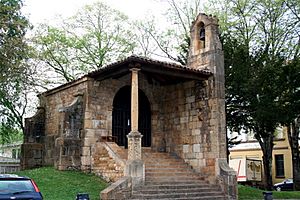Church of Santa Cruz de Cangas de Onís facts for kids
Quick facts for kids Church of the True Cross ofCangas de Onís Iglesia de la Santa Cruz de Cangas de Onís |
|
|---|---|

The entrance to the chapel today
|
|
| Religion | |
| Affiliation | Roman Catholic |
| Province | Asturias |
| Ecclesiastical or organizational status | Chapel |
| Year consecrated | 27 October 737 |
| Location | |
| Location | |
| Architecture | |
| Architectural type | Chapel |
| Architectural style | Pre-Romanesque |
| Groundbreaking | 437 |
The Church of the True Cross of Cangas de Onís is a small Roman Catholic chapel. It is located in Cangas de Onís, a town in northern Spain. This town was once the first capital of the Kingdom of Asturias.
This special chapel was built on top of an ancient stone tomb called a dolmen. A dolmen is a prehistoric structure made of large stones. King Favila of Asturias and his queen, Froiliuba, started building the chapel in the year 737. It was officially opened on October 27, 737. A stone from its original building is very important. People call it the first written record of the Reconquista. The Reconquista was a long period when Christian kingdoms took back land in Spain.
The Santa Cruz chapel once held the famous Cruz de la Victoria. This is an oak cross that Pelagius of Asturias, King Favila's father, supposedly carried. He carried it during the important Battle of Covadonga. This chapel was likely the first church built after the Islamic invasion of Spain in 711.
History of the Chapel
The chapel has been rebuilt completely two times. The first time was in 1632. The second time was after it was destroyed during the Spanish Civil War in 1936. After the war, local leaders made a decision. They wanted to show the ancient dolmen underneath the chapel. This dolmen had been hidden by churches since the 300s. Only the original foundation stone from the first building still exists today.
Important Burials
- Favila of Asturias
- Froiliuba (King Favila's wife)
Images for kids
-
The foundation stone reads (in translation from the original Latin):
. . . and his children, for whom by it, O Christ, by your sacrifice be all your grace, and after the course of this life may they reach your generous mercy. Here were consecrated altars to Christ by the priest Asterius, on the three-hundredth day of the year in the sixth age of the world in the Era 775.
See also
 In Spanish: Capilla de Santa Cruz (Cangas de Onís) para niños
In Spanish: Capilla de Santa Cruz (Cangas de Onís) para niños
- Asturian architecture
- Catholic Church in Spain



